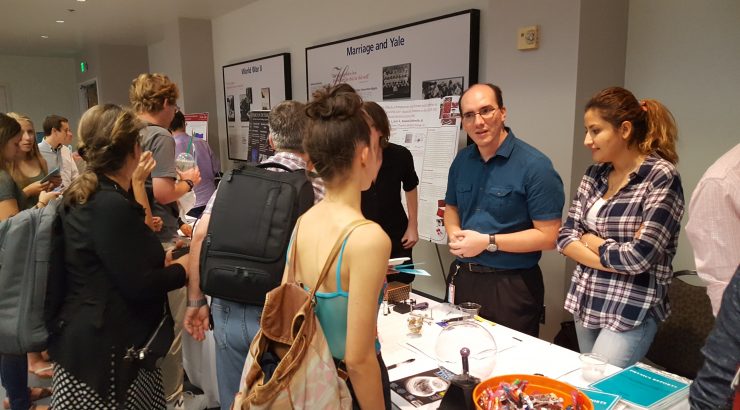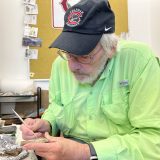2017-18 Hands-on Scientific Research Opportunities for Undergraduates Science professors showcase research opportunities at OURCA's 2017 Faculty Research Expo
October 12, 2017
Wondering what kinds of hands-on research experiences science faculty offer students? Are you a Chapman undergraduate looking to participate in scientific research? Check out the descriptions below and then contact the professor to inquire about open opportunities.
Last week marked the inaugural Discover Research and Arts Week (DRAW) hosted by the Office of Undergraduate Research and Creative Activity (OURCA), and many Schmid College, Crean College and School of Pharmacy professors participated in the 2017 Faculty Research Expo held during DRAW. This popular annual event features faculty from across the university in a tremendous display of the breadth of scholarly and creative activity at Chapman. Students talk personally with each professor about their research and how they can get involved. Students attend this event each year and for many it sparks research experiences that are “the highlight of their Chapman University experience,” explains OURCA in the event brochure.
Did you miss it? Check out opportunities with Chapman science professors below. Special thanks to OURCA’s Lisa Kendrick for sharing these descriptions.
Catalysis (Cat) Lab with Prof. Jerry LaRue
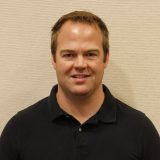
Jerry LaRue, Ph.D.
Overview of scholarly research/creative activity: Dr. LaRue’s research uses light to study the interactions and dynamics between molecules during chemical reactions. This knowledge can be used to help selectively steer reactions, something that we still know very little about, to meet the challenges of tomorrow, such as climate change and pollution control.
Specific projects working on: The research in my group is focused around three themes: catalysts, protein interactions, and structured light.
Catalysts: Catalysts are the hidden workhorses of chemistry in society: widely used in industry; they help reduce energy consumption, minimize pollution, synthesize chemicals, and produce food. Catalysts lower the activation energy barriers for desired reaction pathways, resulting in more efficient chemical reactions. My group synthesizes novel metal-based catalysts, including gold nanoparticles, to study and control catalytically important reactions, such as CO oxidation and CO hydrogenation. These projects include collaborations with Stockholm University and Stanford University to use femtosecond optical lasers, x-ray free-electron lasers, and synchrotron light sources.
Protein interactions: Calmodulin (CaM) is an important calcium sensing protein. Projects include how CaM interacts with the HIV matrix protein and alpha-synuclein, an important protein linked to Parkinson’s disease.
Structured light: Structured light is light with highly structured interference patterns that give the light extra properties, such as orbital angular momentum. These properties can potentially be used to manipulate the motions of molecules during chemical reactions. Projects are underway to develop new methods of creating structured light and to develop novel undergraduate physics lab experiments that highlight these exotic properties of light.
Number of students looking to work with: 3-4
Time commitment for student(s): Meet once/week and expected 3 hours or more for the project per week
When students are needed: Fall 2017,Spring 2018,Summer 2018
What would the student be expected to do: Lab experiments
Requirements for students who work with you: Completed first year general chemistry
Center of Excellence in Earth Systems Modeling and Observations (CEESMO) with Profs. Menas Kafatos, and Seung Hee Kim
Overview of scholarly research/creative activity: The Center of Excellence in Earth Systems Modeling & Observations (CEESMO) is an interdisciplinary research unit. The center focuses on observations of the earth and modeling and analyzing the earth systems with particular emphasis on natural hazards and climate change impacts.
Specific projects working on: Relationship between Climate Variability, Wildfire Risk, and Wildfire Occurrence in Wildland-Urban Interface of the Southwestern United States: identify climate variability using multiple climate indices closely related with droughts. Also, we investigated climate variability and its relationship on local wildfire potential.
Assessment of Wildfire Risk in Southern California with Live Fuel Moisture Measurement and Remotely Sensed Vegetation Water Content Proxies: Live fuel moisture, the water content of live herbasceous plants, is a critical parameter in fire ignition. We established models to evaluate the predictability of LFM in Southern California using Satellite data.
Responses of Agroecosystems to Climate Change: Specifics of Resilience in the Mid-Latitude Region: examines the productivity and resilience of agroecosystems in the Mid-Latitude Region.
Application of space and ground technologies for disaster risk mitigation: Multi-sensor Web for pre- earthquake processes:developing crosscutting Sensor web for integrating multi parameter sensor networks in near space and on the ground to detect pre-earthquake phenomena.
Validation of Lithosphere-Atmosphere-Ionosphere-Magnetosphere coupling as a concept for “geospheres” interaction: advance the physical concept of the coupling mechanism between lithosphere, atmosphere, and ionosphere associated with major natural Earth processes as earthquakes, tsunamis, typhoons, volcanoes and climate change.
Number of students looking to work with: 3-4
When students are needed: Fall 2017,Interterm 2018,Spring 2018,Summer 2018
What would the student be expected to do: Support research activities
Requirements for students who work with you: Programming skills in languages such as FORTRAN, C, Python and MATLAB.
Chapman Brain Institute with Profs. Amir Raz and Uri Maoz
Overview of scholarly research/creative activity: The Brain Institute comprises a network of interdisciplinary researchers in psychology, neuroscience, neurology, economics, computation, engineering, and so on. Highlighting stimulating communication and criticism, we unify behavioral & brain science, with an eye to clinical and real-world applications, AI, and philosophy of mind.
Specific projects working on: Research questions we address include topics such as attention, consciousness and altered states of consciousness, hypnosis, meditation, placebos, cognitive control, free will, volition, decision-making, moral choice, sense of self, agency and authorship, self-regulation, neurofeedback, deception, perception and psychophysics, machine learning and deep learning, computational models of higher brain functions, mental health, and psychopathology.
Number of students looking to work with: 5 or more
Time commitment for student(s): At least 8 hrs per week
When students are needed: Fall 2017, Interterm 2018, Spring 2018, Summer 2018
What would the student be expected to do: Literature search & summary, design & run human-subject experiments, analyze data
Requirements for students who work with you: Enthusiasm about the mind and brain is required. The ability to work with human subjects is important. Computational background and programming skills are preferred.
Comparative Biomaterials Lab (Fudge Lab) with Prof. Douglas Fudge

Prof. Douglas Fudge, Ph.D.
Overview of scholarly research/creative activity: We do inter-disciplinary marine biology research that aims to answer questions about the biomechanical function of animals and animal biomaterials. Current research is focused on the biomechanics of predator defense in hagfishes, and hagfish locomotion.
Specific projects working on: Biomechanics of burrowing in hagfishes; Biophysics of thread deployment in hagfish slime; Biophysics and biochemistry of hagfish mucus; Hagfish anesthesia; Cell biology of hagfish slime glands; Functional genomics of hagfish slime glands
Number of students looking to work with: 3-4
Time commitment for student(s): Lab meeting once/week (1 hr), individual meeting once/week (30 min), enrol in BIOL 491 (2-3 credits preferred)
When students are needed: Summer 2018
What would the student be expected to do: Lab experiments, experimental design, animal care, library research
Requirements for students who work with you: Enthusiasm for marine biology and research
Prof. Susan V. Duff
Overview of scholarly research/creative activity: Dr. Duff’s research focuses on the assessment, acquisition, and recovery of prehension. Most recently, she has been collaborating with others on the design of home-based assessment and intervention strategies for infants, children, and adults with peripheral and central neurological disorders.
Specific projects working on: 1) Assessment of Interlimb Coordination in Children and Adults with Hemiparesis. We are using inertial sensors to examine upper extremity interlimb and intralimb coordination during ADL tasks and standardized clinical assessments of bimanual function. 2) Home-based Biofeedback to Augment Recovery After Perinatal Brachial Plexus
Injury. We are examining the feasibility and outcome of a 2-week parent-run intervention to increase muscle activation and prehensile function in young infants who sustain perinatal brachial plexus injury.
Number of students looking to work with: 3-4
Time commitment for student(s): Minimum 2 hours per week with a maximum of 10 hours per week
When students are needed: Fall 2017,Interterm 2018,Spring 2018,Summer 2018
What would the student be expected to do: Setup of experiment in the lab or in the home with supervision
Requirements for students who work with you: Able to communicate in Spanish, good interpersonal skills, and skilled with Microsoft Excel. A car would be helpful.
Additional Information: These are two very different projects. One project will be done on campus and involves data collection with older children/adults or data analysis. The other project will be done in the home environment for data collection or the lab if helping with data analysis. Both projects are ongoing so start up can be soon.
Prof. Sherif Elshahawi
Overview of scholarly research/creative activity: The major focus of the Elshahawi lab is to discover and develop natural product compounds, genes and enzymes to provide new drug leads against bacterial infections and cancer to strengthen the drug discovery pipeline. Research in the Elshahawi lab lies at the interface of chemistry and biology.
Specific projects working on: Dr. Elshahawi’s research is focused on four main areas:
(1) Isolation of microorganisms from untapped environments capable of producing biologically active small molecules; isolation and structure elucidation of these compounds using various spectroscopic techniques
(2) Identification of the genes, enzymes and mechanisms involved in the biosynthesis of bioactive natural products; diversification of drugs using biocatalysts
(3) Characterization and engineering of late stage tailoring enzymes for drug diversification for improvement of bioactivities and/or physicochemical properties
(4) Identification of the chemical arsenal of pathogenic organisms and their biosynthetic machinery.
Prof. Rosalee Hellberg

Prof. Rosalee Hellberg, Ph.D.
Overview of scholarly research/creative activity: My research program is focused on the development and application of rapid methods for the detection of food fraud and food contaminants.
Specific projects working on: My research on food fraud is dedicated to the development and application of molecular techniques to identify meat and seafood species in food products. My research team has published numerous studies that utilize methods such as DNA barcoding and real-time PCR to reveal undeclared species in food products, including pet foods, game meats, and seafood products. My research on food contaminants is focused primarily on the development and application of rapid methods to concentrate, detect and differentiate foodborne pathogens, such as norovirus, Salmonella, and Listeria.
Number of students looking to work with: 1-2
Time commitment for student(s): 20-30 hours per week
When students are needed: Summer 2018
What would the student be expected to do: Lab experiments
Requirements for students who work with you: Completed introductory lab courses in the sciences.
Institute for Quantum Studies with Profs. Justin Dressel and Matthew Leifer

Prof. Justin Dressel, Ph.D.
Overview of scholarly research/creative activity: The Institute for Quantum Studies at Chapman University supports a broad set of research initiatives in quantum mechanics, with many international collaborators visiting yearly. We specialize in the study of quantum foundations, quantum information, quantum computing, quantum metrology, quantum sensing, and other quantum technology.
Specific projects working on: There are many ongoing parallel threads of research in the Institute. Interested students should contact faculty members involved with the topics below that they find most interesting.
- Applications of the quantum weak value and superoscillations (Aharonov, Tollaksen, Dressel)
- Quantum computing with superconducting devices (Dressel)
- Quantum information theory (Leifer, Dressel)
- Quantum information processing with optical systems (Dressel, LaRue)
- Ontological status of the quantum state (Leifer, Aharonov, McQueen)
- Foundations of quantum mechanics (Leifer, Aharonov, Tollaksen, Dressel, McQueen)
- Topological features of quantum dynamics and cosmology (Buniy, Aharonov)
- Quantum field theory and cosmology (Buniy, Nayeri)
- Quantum contextuality (Leifer, Dressel, Tollaksen)
- Gamification for quantum pedagogy (Dressel, Leifer)

Prof. Matthew Leifer, Ph.D.
Number of students looking to work with: 3-4
Time commitment for student(s): Flexible
When students are needed: Fall 2017,Interterm 2018,Spring 2018,Summer 2018
What would the student be expected to do: Several possibilities: literature research, calculations, computation, optical lab work
Requirements for students who work with you: Strong math or computing background, interest in fundamental questions.
Additional Information: Work is professor-specific, so talk to whomever is doing something that interests you, and something can usually be arranged.
International Space Station Archaeological Project with Profs. Justin Walsh and Erik Linstead

Prof. Erik Linstead, Ph.D.
Overview of scholarly research/creative activity: Our project is the first archaeological study of a space habitat — in this case, the International Space Station (ISS). We seek to understand evolving cultural, social and material structures in the ISS’s unique environment.
Specific projects working on: We propose to use machine-learning techniques to enable social science research in a completely new context: outer space. Our case study subject is the International Space Station (ISS). We seek to understand evolving cultural and social structures in the ISS’s unique environment by observing and analyzing its material culture from an archaeological perspective. Remoteness and cost are obstacles to employing traditional archaeological survey methods in Earth orbit, however, making it necessary to deploy new methodologies. Chief among these is the use of the millions of images generated by space agencies and crew showing life onboard the station during its almost 17 years of habitation. We will classify the associations between objects, spaces, and crewmembers by cataloguing these items from the images into a database, indexing them for time using the images’ metadata. This will allow us to choose any moment and study the station’s development and occupation, much like a stratigraphic layer in an archaeological excavation. We can then map changes in the function of spaces, or the association of people and objects with particular spaces, over time. Such insights into how crew members adapt to their environment and use the objects around them have never been available before, and have applications for future mission design.
Kaur Lab with Prof. Kamaljit Kaur
Overview of scholarly research/creative activity: Dr. Kaur’s research in Biomimetics and Molecular Engineering focuses on two areas: (i) Cancer Targeting Peptides for breast cancer treatment and (ii) Antimicrobial Peptides for developing peptide-based biosensors.
Specific projects working on: Dr. Kaur’s research program in “Cancer targeting peptides” involves engineering improved cancer targeting peptides for increased therapeutic efficacy of current chemotherapeutics (CTs). Chemotherapy is the treatment of choice for most cancers including breast cancer. However, it is rarely curative and mostly ineffective due to intolerable toxicities of the CTs. CTs are potent cytotoxic agents that enter healthy tissues in the body with indiscriminate toxicity and do not preferentially accumulate at the tumor (cancer) sites. One of the most effective strategies to improve the specific uptake of these CTs to the cancerous cells in tumors is to use targeting ligands, such as cancer targeting peptides which bind to specific receptors on cancer cells. Kaur group is currently working on design, synthesis, and evaluation of peptide-drug conjugates where a CT doxorubicin is conjugated to a breast cancer cell targeting peptide that facilitates delivery of the peptide-drug conjugates to breast cancer cells sparing normal noncancerous cells. This project is funded by NIH-National Cancer Institute.
Her research program in Antimicrobial Peptides (AMPs) involves development of peptide-based biosensors. Specially, she concentrates on bacteriocins that are potent AMPs against Listeria monocytogenes, Salmonella, and E. coli, and are produced by lactic acid bacteria (e.g. yogurt). These peptides bind bacteria with high affinity allowing specific detection of pathogenic bacteria.
Number of students looking to work with: 1-2
Time commitment for student(s): As much as possible
When students are needed: Fall 2017,Spring 2018,Summer 2018
What would the student be expected to do: Peptide synthesis, peptide purification using HPLC, characterization of peptides, mammalian cell culture
Requirements for students who work with you: Good to have background in organic chemistry and biochemistry
Additional Information: There is some funding available for the students.
Kim Environmental Geochemistry Lab with Prof. Christopher Kim

Prof. Christopher Kim, Ph.D.
Overview of scholarly research/creative activity: The Kim Environmental Geochemistry (KEG) Lab studies the chemistry of geological processes that have environmental impacts. Students conduct hands-on lab experimentation, data analysis, and trips to a X-ray facility at Stanford University for sample analysis. Self-learners working independently in a supportive group setting desired!
Specific projects working on: 1. Nanoparticle aggregation and metal adsorption/desorption: iron oxyhydroxide nanoparticles are made in our lab, aggregated to varying extents under different solution conditions, and then exposed to dissolved metals to examine how well they adsorb and retain these metals. Direct applications to the treatment and remediation of contaminated waters can result from this work. 2. Arsenic contamination in abandoned gold mines throughout California: students help measure trends in concentration, distribution, and speciation of arsenic in mine wastes as a function of particle size and weathering. 3. Arsenic bioaccessibility/bioavailability in mine wastes: this involves conducting leach extraction tests designed to simulate the ingestion or inhalation of fine-grained mine waste particles, with correlations to toxicity in humans and other animals.
Number of students looking to work with: 3-4
Time commitment for student(s): One 20-minute meeting a week, usually on Monday morning, minimum 4 hours of work in the lab during the week, 1 hour lab group meeting towards the end of the week, participation in University Research Day at the end of the semester.
When students are needed: Spring 2018,Summer 2018
What would the student be expected to do: Students take part in every aspect of research in the lab, including: literature review and presentation, design/refinement of experimental protocol, conducting experiments, analyzing and processing data, presenting work at group meetings and possibly conferences.
Requirements for students who work with you: First year chemistry (CHEM 140/150), Moderate proficiency in Microsoft Excel, Ability to fulfill time commitment expectations (see below), Room in schedule to enroll in 2-3 units of CHEM291/491 or ENV291/491 (academic year only; I can pay for summer research assistants)
Additional Information: The Kim Environmental Geochemistry Lab has been one of the most active undergraduate research labs in the sciences at Chapman, with many members going on to graduate programs and careers in the sciences; check out our website or talk to our current members for more info!
Prof. Cyril Rakovski
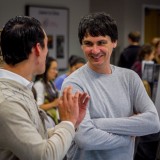
Prof. Cyril Rakovski, Ph.D.
Overview of scholarly research/creative activity: My research interests are, algorithmic model building for multidimensional data, epidemiology and medical data analysis, time series analysis, longitudinal data analysis, case-control studies with complex sampling designs, statistical genetics, survey data analysis, and nonparametric methods.
Specific projects working on: I am currently working on developing a novel, high Precision, comprehensive analytical and computational algorithm for automated classification of arrhythmia types which is big data collaborative multi-center international research project supported by a two-year Kay Family Data Analytics grant. This endeavor will design and implement a comprehensive analytical method that incorporates wavelets for preliminary data feature extraction, alignment and aggregation, principal component and canonical correlation analysis for dimensionality reduction due to redundancy of ECG signals coming from multiple leads, automated multinomial logistic regression model selection that identifies the best classification algorithm, kernel smoothing and a corresponding, novel, Kramer Von Mises type hypothesis testing based classification.
I am working on:
- detecting and assessing the adjusted effects of new and established risk factors for diabetes, bipolar disorder, cancer, asthma, congenital heart defects, and Alzheimer’s disease.
- extending automatic generalized linear model building to longitudinal and complexly sampled survey data scenarios.
- developing and implementing new statistical methods for detection of extreme climate events.
- developing and implementing new statistical methods for enhanced short term forecasting of stock values.
Number of students looking to work with: 1-2
Time commitment for student(s): Once a week with 5 hours of commitment
When students are needed: Spring 2018
Marine Invertebrate Lab (MIB) with Prof. William Wright
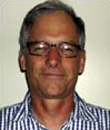
Prof. William Wright, Ph.D.
Overview of scholarly research/creative activity: I study behavior of marine invertebrates at different levels, ranging from molecular to ecological.
Specific projects working on: Our studies fall into three different categories.
1. Learning and memory in sea hares. My students and I take advantage of a simple invertebrate nervous system to study learning and memory. We are interested in the mechanisms and ecology/evolution of learning. This wide view leads us to explore the inner workings of sea-hare ganglia in the laboratory, and the behavioral ecology of sea hares in the wild.
2. Territorial ecology of the owl limpet, Lottia gigantea. We study the behavior of this local intertidal snail, including how that behavior is impacted by climate change. “Limpet wrasslers” in my lab don wetsuits and wade right into the behavioral world of the limpet.
3. Feeding behavior of hermit crabs. This amazing denizen of our local tidepools has led us to multiple interesting questions: How do sea hares chemically defend themselves? How do hermit crabs detect the odor of predators? How is chemical detection of predators compromised by climate change? How does global warming influence feeding? Almost all of these experiments are in the lab, though the future is bright for a field component.
Number of students looking to work with: 3-4
Time commitment for student(s): 1.5 h per week meeting, 8 h/week research
When students are needed: Interterm 2018,Spring 2018,Summer 2018
What would the student be expected to do: Lab experiments on hermit crabs or sea hares, field experiments on limpets.
Requirements for students who work with you: Hard-working
Prof. Innokentiy Maslennikov
Overview of scholarly research/creative activity: My research is focused on application of a variety of Biochemical, Biophysical, and computational methods to the problems of Structural Biology, Drug Design, and Drug Development. Areas of interests: NMR spectroscopy studies of proteins and peptides; Structural Biology of membrane proteins; NMR studies of Drug-Target interactions.
Specific projects working on: Offered research projects involve the following:
(1) Study of Drug-Target interactions. NMR spectroscopy is a very powerful method of (i) non-invasive analysis of interactions between molecules with (ii) atomic resolution. While it cannot provide extreme high-throughput in screening of millions of drug candidates, NMR is the only method of identification in native-like environment of atoms and groups that define ligand-target interactions.
(2) Synthesis of proteins for structural studies in cell-free system (in vitro protein synthesis). Protein synthesis in bacterial, yeast, insect, or mammalian cells is the major source of recombinant proteins for functional and structural studies. Unfortunately, many proteins could not be produced in the life cells due to either toxicity of a target protein or it’s low stability and fast degradation in the living cell. The Cell-Free systems helped to resolve these problems and introduced an efficient way of specific labeling of target proteins for further studies.
(3) Analysis of sequence structure function relationships in proteins. The problem of protein sequence-function relationship is as old as we know the basis of a protein sequence. Here we are using specific example of protein sequence-function relationship is as old as we know the basis of a protein sequence. Here we are using specific example of
cytoplasmic domains of T-Cell receptor subunits to understand the relations between small differences in conserved sequence motifs and large differences in regulation of activation of the T-Cells and initiation of the immune response.
Number of students looking to work with: 1-2
Time commitment for student(s): 8-10 hours/week
When students are needed: Fall 2017,Interterm 2018,Spring 2018,Summer 2018
What would the student be expected to do: Depending on a project – lab experiments, analysis of literature and databases
Requirements for students who work with you: Good in Math, Chemistry, and Biology, preferably Biochemistry. Good with computers and technology.
Additional Information: I have a number of my projects that you may find interesting. Also, after some introduction time, you can bring your own ideas to check how they work.
Prof. Reza Mehvar
Overview of scholarly research/creative activity: We study how the physiological maladaptations associated with liver disease affect drug-transporters, metabolizing enzymes, and membrane-integrity at the liver and brain. This could have important implications for cirrhosis patients taking pain medication, anti-depressants, or other drugs which target the central nervous system.
Specific projects working on: Hepatic encephalopathy is a neuropsychiatric complication of liver disease. The symptoms can progress from irritability to confusion and cognitive dysfunction, and in the most severe cases, coma and death. This indicates a dysfunctional cerebral vascular unit, which depends upon the integrity of the blood-brain-barrier, and a suite of transporters and enzymes to form a protective metabolic barrier.
Current Projects:
1. Develop and optimize improved methods for in vitro drug metabolism studies in rat brain tissue, and compare subcellular distribution and function of these enzymes. This project involves learning about subcellular fractionation, mass spectrometry, and immunoblotting.
2. Determine the effect of liver failure on the functional status and expression of drug metabolizing enzymes, drug transporters, and blood-brain-barrier permeability in vivo and in vitro in the rat. This projects involves animal handing, injections, surgery, and organ collection. Collected tissues and fluids will be analyzed with mass spectrometry, and tissues will undergo sub-cellular fractionation to characterize drug transporter/metabolizing enzyme protein expression and function.
Number of students looking to work with: 1-2
Time commitment for student(s): Minimum 8 hrs commitment to project/week.
When students are needed: Fall 2017,Interterm 2018,Spring 2018,Summer 2018
What would the student be expected to do: Lab experiments and bench-work.
Requirements for students who work with you: Students should have completed first year general chemistry and general biology.
Prof. Keykavous Parang
Overview of scholarly research/creative activity: The emphasis of my research lies at the interface between chemistry and biology with specific proposals being focused in the fields of organic chemistry, medicinal chemistry, nanomedicine, and drug delivery. Our research can be appropriately described as “the application of synthetic organic chemistry to problems in biology.”
Specific projects working on: Specific areas currently under investigation include (1) using peptides as cell-penetrating molecular transporters in drug delivery; (2) designing protein kinase inhibitors as anticancer agent; (3) development of multifunctional anti-HIV, anticancer, and antibacterial agents; and (4) designing peptide nanomaterials for tissue engineering and nanomedicine.
One major area currently under investigation is to design peptide nanomaterials for applications in drug delivery and tissue engineering. The objective of this project is to design and evaluate peptide nanomaterials as cell-penetrating nuclear targeting agents, molecular transporters of bioactive cell-impermeable compounds, or self-assembled scaffolds for tissue engineering. This study will document the potential for new hybrid peptide-drug assemblies that may be used for the non-covalent or covalent targeted delivery of bioactive molecules including cell-impermeable compounds with biological significance. It is our expectation that this transformative strategy will lead to a broadly applicable platform for carrier-mediated drug delivery of therapeutic agents.
Number of students looking to work with: 1-2
Time commitment for student(s): Minimum 10-15 hours per week.
When students are needed: Interterm 2018,Spring 2018,Summer 2018
What would the student be expected to do: lab experiments
Requirements for students who work with you: Have some chemistry or biology background.
Prof. Anuradha Prakash

Prof. Anu Prakash, Ph.D.
Overview of scholarly research/creative activity: Our research focuses on the effect of irradiation on the quality of fruit treated by irradiation for insect disinfestation with the ultimate goal of eliminating global trade barriers by reducing the threat posed by invasive pests.
Specific projects working on: We have worked on a variety of fruit-peaches, Navel oranges, blueberries, grapes, pears, and sweet cherries. In general, most fruit tolerate phytosanitary doses without impairing quality. Navel oranges were an exception, with irradiation leading to pitting. Packaging with modified atmospheres helped extend the shelf-life of blueberries and sweet cherries. Shelf life of irradiated fruit was generally superior than fruit fumigated with methyl bromide. Based on our research showing that irradiation preserves peach quality, one shipment of irradiated peaches was exported to Mexico in 2015. A second shipment of peaches was irradiated upon arrival in Mexico in 2016. This was a significant achievement in realizing phytosanitary irradiation as an alternate treatment for export commodities. In this coming year, we are evaluating the effect of irradiation on the quality of California apples, and specifically the effect of maturity stage and additional treatments the fruit receives.
Number of students looking to work with: 1-2
Time commitment for student(s): 5-10 hours/week
When students are needed: Fall 2017,Interterm 2018,Spring 2018
What would the student be expected to do: Laboratory experiments
Requirements for students who work with you: Chemistry, biochemistry, or biology majors in their junior or senior years.
Prof. Rahul Soangra
Overview of scholarly research/creative activity: Dr. Soangra’s research interests are focused on improving the overall quality of life of elderly patients by understanding the specific mechanisms that result in mobility and motor control limitations and by developing novel rehabilitation strategies that target those limitations.
Specific projects working on: Gait Rehabilitation and Research Lab (GRRL) investigates intervention solutions for fall prevention. Our research investigates the effectiveness of perturbation training for enhancing postural and dynamic stability in individuals with neurological or musculoskeletal disorders. We also design fall assessment portable tools such as smartphone apps and use inertial sensors in understanding movement characteristics. Our research involves understanding Activities of Daily Living (ADL’s) in various pathological populations using inertial sensors. Our research investigates the use of sensor based technological systems for enriched rehabilitation in clinical and at home for patients with musculoskeletal and neurological problems.Research in Gait Rehabilitation Research Lab explores stability and stride interval complexity due to controlled gait and postural perturbations and during more complex cognitive and functional tasks while walking. The ultimate goal of our research is to improve quality of life of patient population by introducing interventions for movement disorders.
Number of students looking to work with: 3-4
Time commitment for student(s): Meet 2 times/week and 10 hours commitment
When students are needed: Fall 2017,Interterm 2018,Spring 2018,Summer 2018
What would the student be expected to do: Lab experiments, literature research, data analysis, Arduino based product Developments, App developments
Requirements for students who work with you: Passionate to work in the area of Human Gait and Biomechanics and Fall Prevention
Additional Information: Situated at Rinker Campus; All research work will be scheduled at Rinker Campus.
Tiwari Laboratory with Prof. Rakesh Tiwari
Overview of scholarly research/creative activity: Our lab is interested in developing small molecules and peptides for therapeutic application. For example developing peptide-drug conjugates (PDC) for various application. Research areas range from the development of new synthetic methods for small molecule and peptide synthesis including a preclinical screening of compounds.
Specific projects working on: 1. Developing Neurotherapeutic Agents: We are interested in developing a potent compound that will modulate the brain derived neurotrophic factor (BDNF)/Tropomyosin receptor kinase B (TrkB) receptor signaling pathways to treat Angelman Syndrome (AS), Parkinson’s, and ALS. AS is a severe neurogenetic disorder that occurs in one in 15,000 live births with no available drug therapy. This project originates based on developed peptidomimetic CN2097 using rational drug design approaches for AS and neuroprotective agents in the lab of collaborator Dr. John Marshall at Brown University. We as a medicinal chemist in this interdisciplinary team of the investigators are interested in designing and synthesizing various analogs of the potent CN2097 compound to tune physicochemical property without changing potency. This proposal harnesses medicinal chemistry-centered strategies to modulate properties of CN2097 and develop libraries of potent analogs. Development of Antimicrobial Agents: Cationic peptides are well reported with the antimicrobial property. This project is developed with our mutual interest with Dr. K. Parang who identified a potent cyclic peptide [W4R4] to kill methicillin-resistant aureus(MRSA) and other resistant strains in the lab assay. The aim and objective of this project are to develop small molecule like compounds to treat MRSA after optimization of core peptide sequence.
Number of students looking to work with: 3-4
Time commitment for student(s): Expected 10 hrs minimum commitment. Allow student to take time off during exam from lab.
When students are needed: Fall 2017,Interterm 2018,Spring 2018,Summer 2018
What would the student be expected to do: Lab experiments and literature research/summary
Requirements for students who work with you: Hard working and enthusiastic
Additional Information: Be excited to avail this opportunity.
Prof. Lilian Were

Prof. Lilian Were. Ph.D.
Overview of scholarly research/creative activity: My current research is focused on determining the preservative and sensory properties of phenolic and melanoidin compounds from coffee, mushroom and sunflower, with the overall goal of enhancing the quality and shelf life of food.
Specific projects working on: We are currently investigating factors influencing chlorogenic acid oxidation- induced greening reaction using sunflower butter cookie as the food matrix. The changes in reactants and product content were quantified and two articles on the greening reaction have been published in tier one journals, with student co-author underlined below
I) Sihui Liang and Lilian Were. 2018. Chlorogenic Acid Oxidation-Induced Greening of Sunflower Butter Cookies as a Function of Different Sweeteners and Storage Conditions Food Chemistry. 241:135-142
II) Sihui Liang and Lilian Were. 2017. Chlorogenic acid induced colored reactions and their effect on carbonyls, phenolic content, and antioxidant capacity in sunflower butter cookies. LWT – Food Science and Technology. doi 10.1016/j.lwt.2017.08.069
In addition to prolonging the shelf life of meat using White button mushrooms and some of the recently completed work was published in article below
III) Hatouf Alnoumani, Zeynep Akyol Ataman, Lilian Were. 2017. Lipid and protein antioxidant capacity of dried Agaricus bisporus in salted cooked ground beef. Meat Science. 129:9-19
Number of students looking to work with: 1-2
Time commitment for student(s): 10 hrs per week
When students are needed: Interterm 2018,Spring 2018
What would the student be expected to do: Lab experiments in addition to literature research to explain data obtained
Requirements for students who work with you: Completed organic or biochemistry
Wetland Biogeochemistry Lab with Profs. Jason Keller and Prof. Cassandra Zalman

Prof. Jason Keller, Ph.D.
Overview of scholarly research/creative activity: Research in the Wetland Biogeochemistry Laboratory explores the relationship between wetland carbon cycling and global change. We work on projects related to soil carbon storage and greenhouse gas fluxes in wetlands ranging from salt marshes in California to northern peatlands in Minnesota.
Specific projects working on: Research in our laboratory focuses on 3 themes.
Theme 1 – Anaerobic microbial decomposition in peatlands. Microbial decomposition of organic matter in anaerobic wetland soils is mediated by a number of microbial processes that ultimately produce CO2 and CH4. We are exploring the mechanistic controls of these processes in wetland soils. Many of our projects investigate the importance of the novel microbial processes – including organic matter reduction and methylotrophic methanogenesis – in peatland ecosystems.

Prof. Cassandra Zalman, Ph.D.
Theme 2 – The response of wetlands to global change. Wetlands store one-third of the terrestrial soil carbon and release globally significant amounts of the potent greenhouse gas CH4 to the atmosphere. Understanding the stability of wetland soil carbon and the response of wetland CH4 flux to global change has important implications in the context of the global climate. We are working on a large climate change experiment that simulates warming and elevated atmospheric CO2 in a northern Minnesota bog.
Theme 3 – Coastal blue carbon. Conceptually, the carbon stored in the soils of coastal wetlands – blue carbon – could be traded on emerging carbon markets to generate a revenue stream for wetland conservation and restoration projects. We are working to quantify greenhouse gas fluxes from blue carbon projects in California.
Number of students looking to work with: 3-4
Time commitment for student(s): Students should be prepared to spend between 6-10 hours per week on research (depending on the particular project). This will include a mandatory weekly laboratory meeting (1 hour) for the entire research team. In general, larger blocks of time (3-4 hou
When students are needed: Spring 2018
What would the student be expected to do: Most of our ongoing projects involve primarily laboratory work. This includes the setup of experiments, the analysis of gas and water samples, data summary and analysis, and the associated routine laboratory maintenance. There are periodically opportunities for field work on some projects. Students also participate in weekly laboratory meetings where they present papers from the primary literature, share progress updates on their projects and provide feedback on projects being presented by their peers.
Requirements for students who work with you: Most importantly, students need to be able to work well in a research team that includes undergraduate researchers, research technicians and faculty. We expect students to take ownership of their projects and to work carefully and professionally when collecting, analyzing and communicating data and results. The most successful students in our research team have a passion for environmental research. Interested students should have course work in biology, chemistry, ecology and/or environmental science. Careful attention to detail and an ability to follow laboratory protocols are necessary. Students are required to maintain laboratory notebooks and manage data in Microsoft Excel.
Prof. Peiyi Zhao
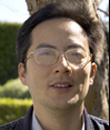
Prof. Peiyi Zhao, Ph.D.
Overview of scholarly research/creative activity: Dr. Zhao’s main research area is ENERGY EFFICIENT integrated circuit design. His paper published in IEEE Transaction on Very Large Scale Integration System in 2011 has been listed as Top 18 most downloaded papers in that journal in 201.
Specific projects working on: My main research area is energy efficient clocking storage element, flip-flop. The date switching activity of flip flop is about 10% in modern chip. The clocked transistors has a 100% switching activity. In high end server processors, for example, POWER7TM and SPARC T4 processors, there are more than 2 million flip-flops, taking up to 20% of the total dynamic power of the processors. Hence flip flop is one of the few dominant contributors to power consumption of a processor. My work seeks to improve flip-flops from the energy, power and speed perspectives by innovations in flip flop circuits.
Number of students looking to work with: 1-2
Time commitment for student(s): Meet once /week
When students are needed: Spring 2018
What would the student be expected to do: Simulation of power and speed of circuits
Requirements for students who work with you: Complete CPSC 330
